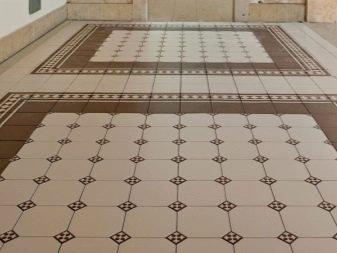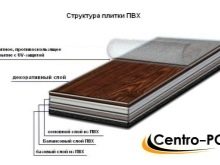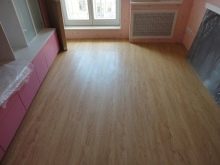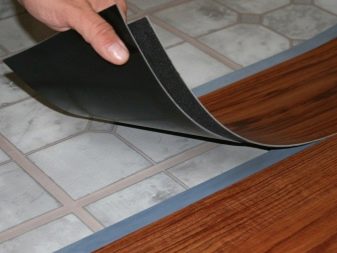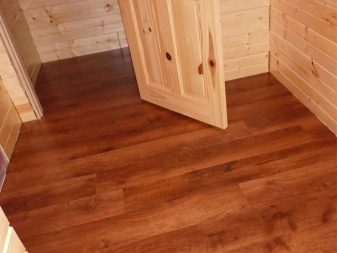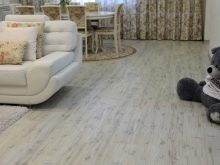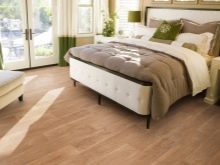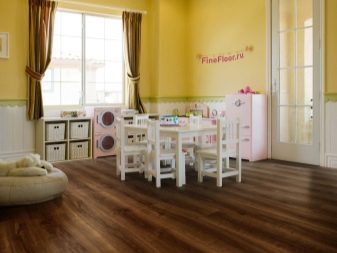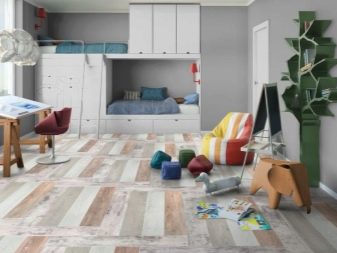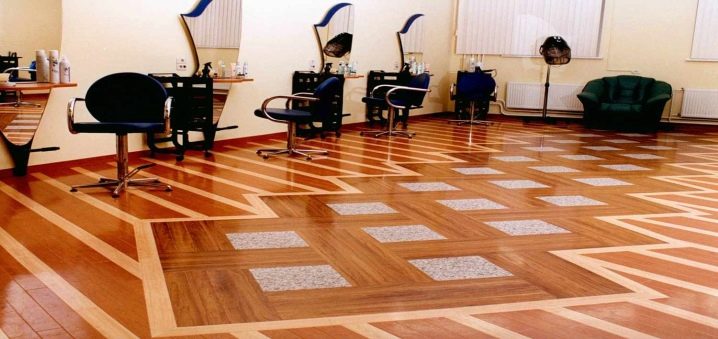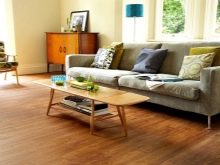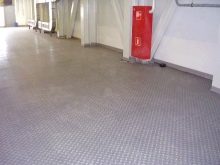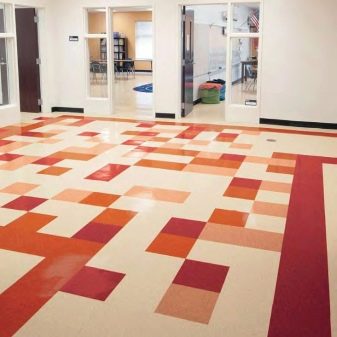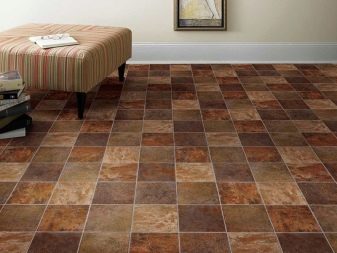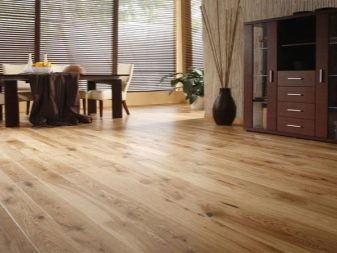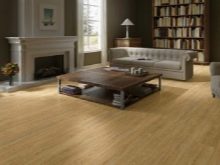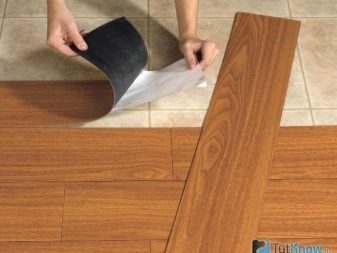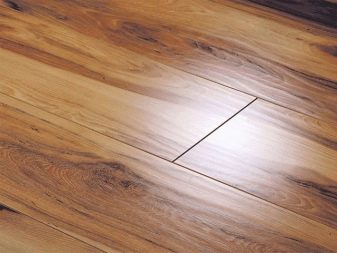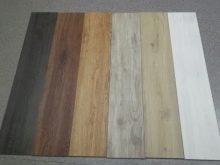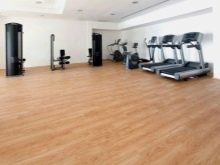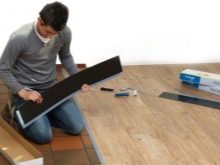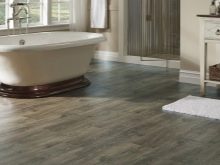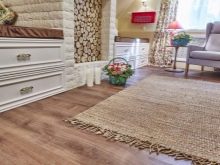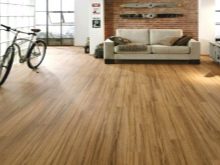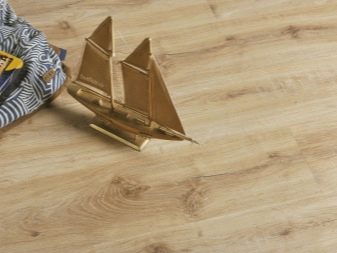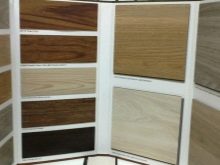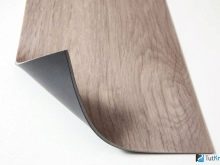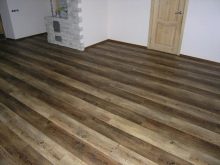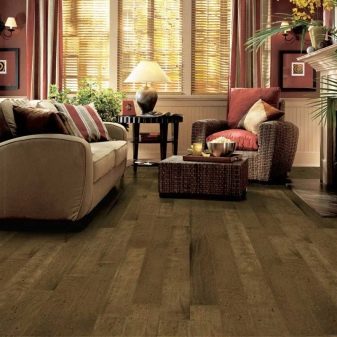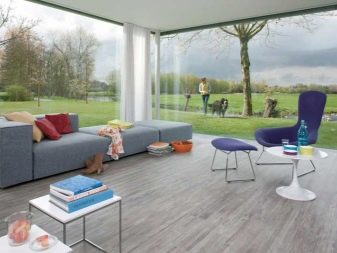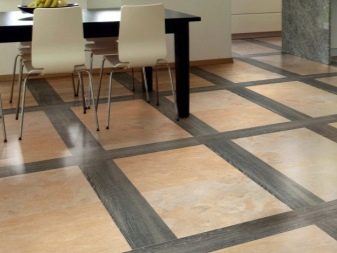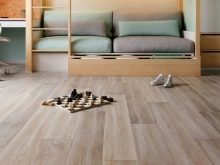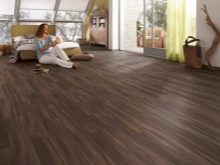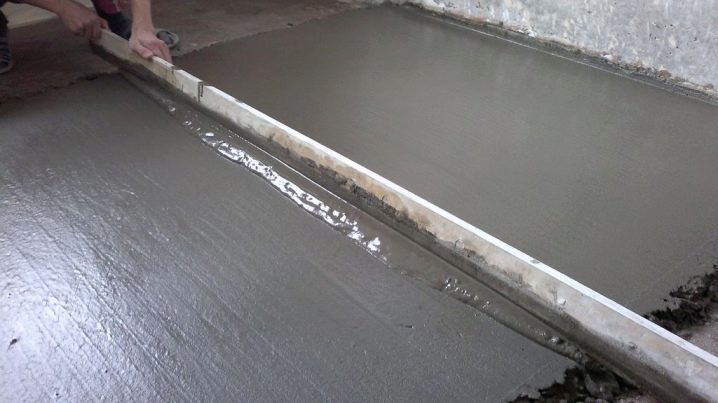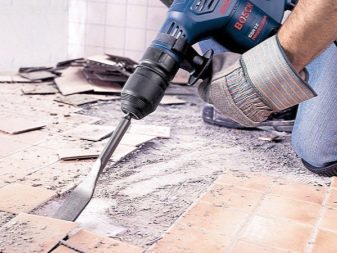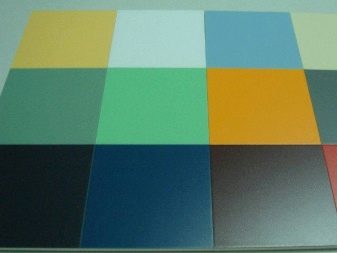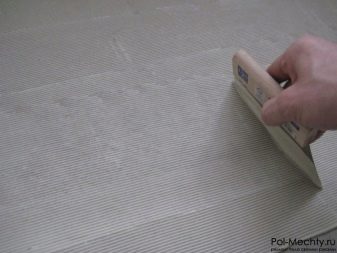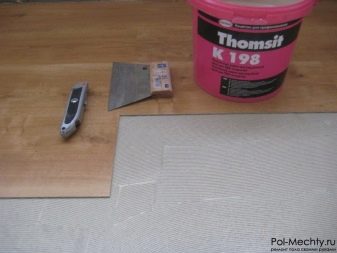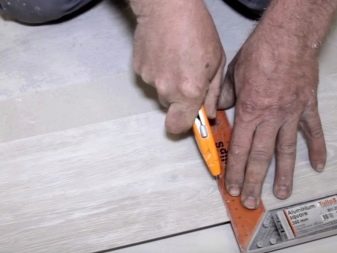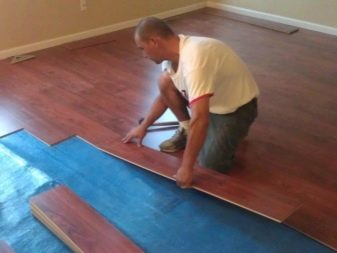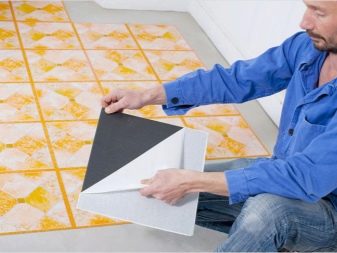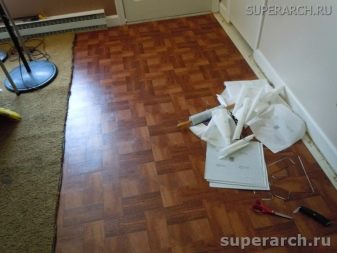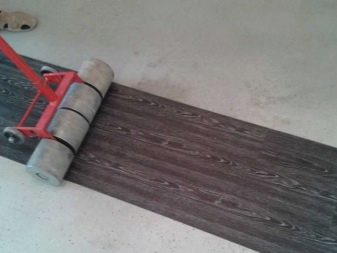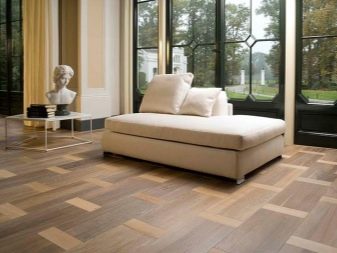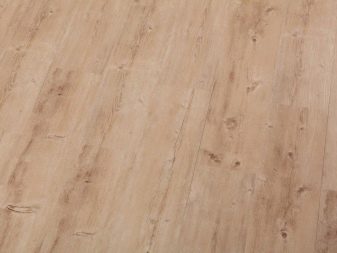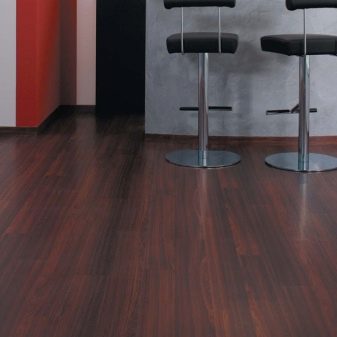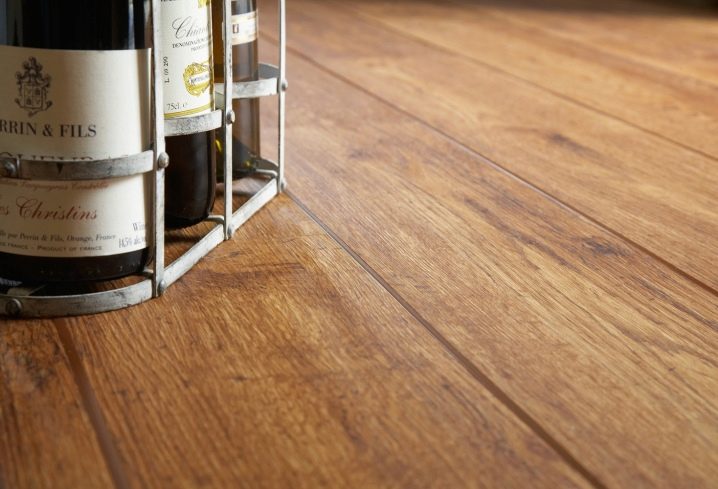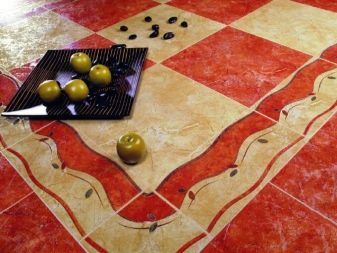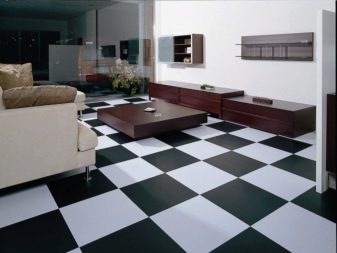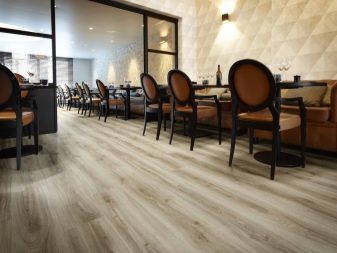PVC floor tiles: advantages and disadvantages
A variety of materials is used for finishing decorative flooring: linoleum, parquet flooring, porcelain tiles, laminate. These coatings have been around for a long time. They managed to gain the trust of millions of consumers due to their excellent performance. Recently, however, many began to give preference to polyvinyl chloride (PVC) floor tile. The coating is characterized by high wear resistance, environmental friendliness and affordable cost.
What it is?
Polyvinyl chloride tiles - flooring, not so long ago appeared on the market. Visually, it looks like premium class linoleum, because of which it received the second name - linoleum. The material goes on sale in the form of rectangles or squares.Due to this feature, the coating is easy to install. PVC tiles are made from the same materials as linoleum.
It has the following structural structure:
- the main layer made of plastic;
- glass fiber inserts designed to stabilize the size of the material;
- decorative layer with a pattern responsible for the aesthetic characteristics of the product;
- specialized protective sheath that protects the coating from mechanical stress.
In the manufacture of linoleum tiles used vinyl resins and stabilizers. Thanks to these substances, the coating has a high density, but it is flexible and elastic.
The thickness of the finished lining varies from 0.5 to 3.5 mm. Also, manufacturers produce vinyl tiles with a single layer thickness of 1.5-2.5 mm.
Scope of application
PVC tile is used for lining the floor surface in the premises of any purposes. It can be used for arranging a warm water floor in the room, which is especially important for private country buildings and apartments located on the first floors. Also, PVC coating can be used for finishing:
- Bathrooms and kitchens. The material will be a great addition to these rooms. Thanks to the safety and high resistance to high humidity tile for a long time will retain its aesthetics in difficult conditions.
- Bedrooms, living rooms, corridors. Due to its decorative material perfectly fit into any of the rooms. An extensive range of products allows you to choose the flooring to any interior space.
- Children's room. This lining does not emit harmful substances during operation, so it is perfect for finishing the rooms in which children live. PVC tiles in the nursery will be the best solution due to environmental friendliness.
- Commercial properties, office space, warehouses and garages. Plastic tile flooring is durable, due to which it is allowed to be used in industrial workshops, exhibition centers, retail outlets.
For the decoration of living rooms and offices, you can purchase household tiles, which have excellent aesthetic qualities, but mediocre technical parameters. In rooms with medium traffic is allowed to use semi-commercial material.Floors on objects with high permeability need to be finished only with commercial cladding.
If you plan to lay such a coating in the production workshop, then you should look at a specialized linoleum tile. It may have refractory properties, resistance to acids or alkalis, depending on the modification.
Features and specifications
Manufacturers of PVC tiles produce two types of material: the first is homogeneous, the second is heterogeneous. Homogeneous lining consists of a single layer. The picture of such material is made in all its thickness, so that the figure does not abrade even with intensive and long-term operation. Homogeneous coating is available in various colors. However, the patterns on such coatings are almost the same.
Heterogeneous material has several layers, the main of which is protective. The second is responsible for decoration: it affects the color and pattern of the tile.
Heterogeneous coating can mimic:
- wooden floor;
- flooring made of natural or artificial stone;
- grass lawn.
Polyvinyl chloride products are highly resistant to various types of alkalis, mineral oils, solvents. They are not afraid of temperature changes, they are able to maintain their original appearance at temperatures ranging from -30 to +60 degrees. The structural density of the material does not exceed 1.4 g / cu. cm, elasticity is in the range of 210-390%.
Thanks to these technical parameters, PVC tile is a serious "competitor" to the floor covering of linoleum, parquet or laminate. At cost, it is more profitable than wood cladding; in terms of laying it is more convenient than linoleum in rolls, warmer than ceramic-tile and stone.
Kinds
Manufacturers offer several varieties of PVC tiles. To decide which type of material is better, you need to understand the features of each of them. So, the following types of linoleum tile are offered on the market:
- Self adhesive Self-adhesive tiles are the most popular material. Such products are in great demand due to simple installation. Thanks to the self-adhesive base, laying of the flooring on the prepared non-free-flowing surface is possible;
- Glue. Adhesive tile - a material that does not have a locking system and a sticky layer.For the installation of products using specialized glue for laying PVC flooring. It reliably interlocks the material with a rough coating;
- Modular with locking connection. For laying of a modular tile the lock connection like "thorn-groove" is applied. For installation of the flooring will not require the application of glue on the wrong side of the material. Precast flooring is ideal for finishing "floating" floors, as well as for rooms with a high level of terrain.
Advantages and disadvantages
The main advantage of PVC tiles is a high wear resistance. The material is capable of maintaining its aesthetic qualities for 10 years. Even if you accidentally damage a piece of flooring, you can always quickly replace it with your own hands.
To restore the surface does not have to dismantle the entire front trim. You just need to remove the damaged fragment and replace it with a new one.
Other advantages of the material include:
- Ease of transportation. The tile differs in small weight. It comes on the market in the form of rectangles or squares, making it convenient to deliver to the right place.
- Original appearance and attractive design.Among the extensive product range, even the pickiest consumer will be able to find the right option.
- High moisture resistance.
- Elasticity and hardness. Thanks to these properties, the tile is able to withstand serious power loads.
- Excellent sound and heat insulation.
- Easy installation. Even a person without experience will be able to lay the material on the base. For the installation does not require specialized knowledge, special skills and abilities.
- Resistance to the formation of mold, harmful to human health and pets. Due to the resistance to the occurrence of fungus tiles can be safely laid in wet and unventilated areas.
- Unpretentious care. PVC tile does not absorb moisture, does not interact with detergents, alkaline compounds. The surface is easy to clean with a damp cloth using any household cleaning products.
- Affordable cost. PVC flooring has a lower price than laminate or porcelain, making this material a budget solution.
- Comfort The tile is soft and smooth to the touch, it is pleasant and warm. When wet, the material does not slip, which is especially important for kitchens and bathrooms.
- Environmental friendliness. Although the material is made from synthetic components, it does not emit odor and hazardous chemical elements.
Like all materials for flooring, PVC tiles are not without flaws. Its negative sides are the unnatural and high risks of tarnishing of the pattern during prolonged exposure to sunlight. Another significant disadvantage of the flooring is the need to carefully level the base before laying. In the presence of mounds, some fragments of the coating may come off, which will require repair of the surface. Also, when installing the tile should not allow water to penetrate the flooring. When liquid enters, the risks of fungus occurrence and reproduction are high.
In general, material deficiencies are not so significant. At observance of rules of installation the covering will serve not one year.
Size selection
Polyvinyl tiles are available in rolls, in the form of square or rectangular panels.
The following sizes of piece products are considered the most popular:
- 30x30 cm;
- 50x50 cm;
- 65x65 cm
Large panels should be chosen for spacious rooms. Small and medium-sized tiles are perfect for small rooms.Choosing the thickness of the material, note that the durability of the finished coating will depend on this parameter. A thin product can quickly lose its aesthetics. If you plan to lay PVC tile in the corridor or rooms with high traffic, it is advisable to look at the options with a thickness of 5 mm. It is best to give preference to heterogeneous materials. They will last longer.
Before buying, you need to calculate the number of tiles required. To do this, multiply the length and width of the room to find the area of the room. After that, you can go to the store, choose your favorite tile and find out its size. To calculate the number of tiles required, you need to divide the area of the room by the area of one panel.
If you want coverage to last as long as possible, learn tips on choosing. Thanks to the recommendations, each buyer will be able to purchase not only beautiful, but also high-quality goods.
Recommendations on the choice of material
The question of how to choose PVC tile, often arises among people who have decided to make repairs in the apartment. Most when buying material prefers beautiful design, regardless of the technical parameters. This is the wrong approach.When choosing a flooring in the first place you need to look at the labeling of products. As a rule, it indicates the class of wear resistance, the number of layers, the type of base and the degree of abrasion.
Linoleum tile has several wear resistance classes:
- 21-23 (household);
- 31-33 (commercial);
- 41-43 (special).
The higher the degree of wear resistance, the stronger and more reliable the material will be, but such products will cost more. You also need to pay attention to abrasion. When marking this indicator is indicated by the Latin symbols T, P, M, F (as the stability decreases).
In the bedroom, where floor loads are minimal, it is allowed to put material from group F. For kitchens or other rooms with high traffic, tiles with a degree of abrasion T will be suitable.
In addition, do not forget to evaluate the external characteristics of the product. The range of materials is quite wide. If desired, you can choose the options with a geometric image, monochrome variations. When choosing a color you need to focus on the design of the room, the shades of wallpaper, furnishings and decor.
For finishing of small rooms give preference to light flooring. Tiles of white, beige and cream tones can visually expand the space. Light material is a winning option for small rooms, dark is relevant for finishing large rooms. Choosing a tile, do not hesitate to feel products. Thus, you can buy a sample that is suitable for both shade and calibration, and for texture.
Installation procedure
To carry out the installation as efficiently as possible, quickly and accurately, you need to know how and in what cases to act.
Preparation for laying
In order to not have to change the flooring next year, it is necessary to adhere to the technology of installation of PVC tiles. Before laying the flooring, read the instructions and technical features of the installed product.
Before you install vinyl tile, you need to carefully prepare the base:
- Install a concrete screed. Before laying the material, make sure that the screed is dry with a hygrometer. Humidity index should not be more than 3%. At high values of this parameter, the risks of premature destruction of PVC panels increase.
- Assess the surface of the subfloor. It should be perfectly smooth.The presence of cracks, mounds and other defects is unacceptable. If the surface is not sufficiently flat, use specialized floor leveling compounds.
- When installing the panels on a wooden base, make sure there are no nails or protrusions on it. Seal the joints between the boards with a putty.
- Dismantle the previously laid coating (flooring, linoleum, or other materials). If necessary, install a new tie, align the base.
- The last preparatory stage is the treatment of the base with a suitable soil composition. Thanks to such actions, the surface will become rigid. It will also reduce its absorbing properties, thereby reducing the consumption of glue.
All work on the preparation and installation of the material should be carried out at a temperature of 15-25 degrees.
Adhesive tile
Before laying the products need to make a markup. To do this, use a tape measure and a pencil to draw two lines intersecting in the center of the room. Through the middle, draw a line parallel to the two longitudinal walls. Focus on this markup when installing the first two rows of PVC panels. After the preparatory work, you can proceed with the installation.
For work required:
- adhesive composition;
- container for the preparation of glue;
- putty knife;
- construction knife for cutting material;
- sponge;
- roller.
Prepare the adhesive composition according to the instructions (indicated by the manufacturer on the package with the mixture). Apply the finished solution to a dry basis with a notched trowel. Even the composition on the surface of the coating (the treated area should not exceed 1 sq. M.) And lay the tile. Apply it carefully, making sure that the glue does not get on the front side of the PVC panel. Try to lay products smoothly, without gaps and offsets. After laying each piece of finish, roll the material with a roller. So you remove air bubbles formed between the subfloor and PVC tiles. Remove any excess glue from the roller with a sponge or soft rag.
It is possible to walk on the established covering already after the lapse of days. At the expiration of the same time, you can put furniture on the floor. To eliminate the risk of furniture damage to the tiles, it is recommended to glue felt pads on the legs.
Castle PVC panels
Castle PVC tiles are equipped with a fastening system, thanks to which the material can be laid without using glue.The resulting floating coating is precast. It can be installed and disassembled 3-4 times. The installation of PVC panels with a tongue and groove lock should be started from the far corner of the room, going from left to right.
To facilitate installation, it is recommended to preheat the material with a hair dryer. Heat exposure will give the product elasticity.
When laying the first row it is recommended to retreat at least 5 mm from the wall. This is done to compensate for thermal expansion. To speed up the locking process of locks, you can use a special rubber hammer, eliminating the risks of damage to the surface of the flooring. If the last row of tiles does not fit into the remaining gap, then the material must be cut. To do this, lay the panel on the installed products groove to the wall, put a mark in pencil. Cut off the excess. Install flooring.
Self adhesive tiles
Installing self-adhesive strips will require a minimum set of tools. You will need a rubber roller, a construction knife, a tape measure and a pencil. The installation of tiles should be carried out from one of the corners formed at the intersection of the lines that connect the middle of the opposite walls.To lay the element, remove from it the protective shell covering the adhesive side. Install the tile on the markup, “walk” on it with a roller to remove air bubbles.
Self-adhesive tiles must be installed end-to-end. Near the walls of the excess material should be cut with a knife, leaving a gap of a few millimeters.
Roll Coating
Installation of the roll material is a simple process that does not take much time.
To stack products, follow these steps:
- Prepare the base, get rid of cracks, dimples and bumps on the surface.
- Measure the length and width of the room.
- Cut the flexible material in accordance with the calculations made. Spread it on the floor for adaptation. The product should “lie down” for about 24 hours.
- After a day on the prepared surface, apply the adhesive composition, apply the flooring material to the floor, roll it with a rubber roller. Remove excess glue with a sponge. The subsequent roll set back to the previous one.
Walking on the laid flooring is possible only after its complete drying. To do this, take at least a day. Upon completion of the work, the edges of the material should be pressed around the perimeter with a baseboard.
How to carry out laying of a tile from PVC, look in the following video.
Manufacturers and reviews
PVC tile is a modern finishing floor material produced by many domestic and foreign companies. The most famous manufacturers are listed below.
- Tarkett. Swedish company producing high-quality materials with a pleasant texture. All products of this manufacturer have several layers, thanks to which they are characterized by increased resistance to abrasion and mechanical loads. Tarkett is the leader in sales of flooring materials in the domestic market. Judging by consumer reviews, Tarkett products have maintained their flawless appearance for 5-10 years. It has the best value for money.
- Decoria. Manufacturer from South Korea. Korean tile contains silver ions. Due to this feature, coatings have environmental friendliness and antibacterial properties. In general, consumers speak positively about Decoria products. They note the affordable price of the material, easy installation and durability of the flooring.
- Armstrong. A PVC tile manufacturing company based in Germany. Collections of products are characterized by high strength, reliability and durability. Most Armstrong tile buyers are pleased with their choice.They note the high aesthetics of the material. According to the consumer, the products are pleasant to the touch, unpretentious in care, resistant to temperature extremes.
- Heat-Pro. Manufacturer of PVC tiles from Denmark. The main feature of the material is the presence of a special protective layer, due to which the coating is able to withstand intense load. According to users, such products long retain their original appearance, even in areas with maximum maneuverability. This is a great solution for commercial premises.
Unfortunately, fake products are often found on the Russian market. It does not meet the stated quality standards. Therefore, when choosing a floor cladding, pay attention to product labeling. It is also better to abandon products offered by unknown or unfamiliar manufacturers.
To verify the quality of products, ask the seller the documents of the goods.
Examples of use in the interior
Manufacturers produce PVC tiles in a wide range. Due to the variety of designs, materials with different tones and textures can be combined in the same room, creating original interior variations.If you like non-standard solutions, you can use PVC tiles as a bright and unusual design object.
Also, with the help of vinyl tiles, you can visually divide the space, for example, to separate the seating area from the place for cooking in the spacious kitchen. To do this, you can use a combination of tiles, imitating wood, and materials "under the stone."
PVC tiles can perfectly fit into any interior. You can easily choose products for a classic style, Provence, Loft, modern. White and dark tiles, materials stylized under wood, pebbles, metals, carpet flooring, textiles - the range is diverse. Choose tiles, create unique floors in any of the premises.


